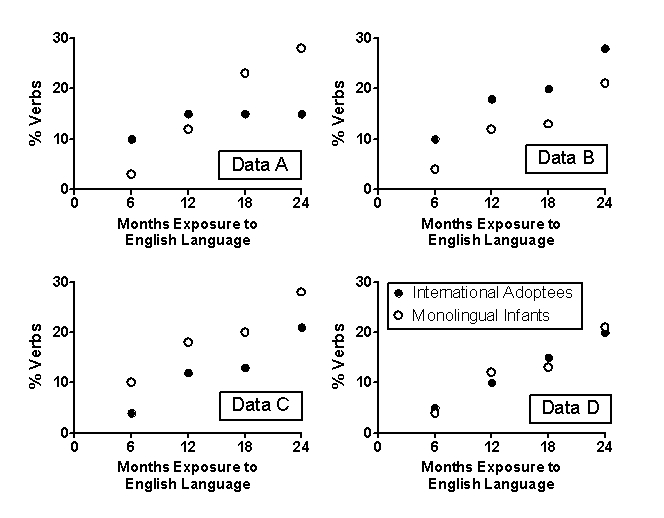Use the following to answer questions
Scenario I
Scenario I is based on and presents results consistent with the following studies:
Snedeker,J. ,Geren,J. ,& Shafto,C.L.(2012) .Disentangling the effects of cognitive development and linguistic expertise: A longitudinal study of the acquisition of English in internationally-adopted children.Cognitive Psychology,65(1) ,39-76.doi:10.1016/j.cogpsych.2012.01.004
Snedeker,J. ,Geren,J. ,& Shafto,C.L.(2007) .Starting over: International adoption as a natural experiment in language development.Psychological Science,18(1) ,79-87.doi:10.1111/j.1467-9280.2007.01852.x
Language development occurs in orderly stages,beginning with one-word utterances and progressing to two-word utterances,simple sentences containing function morphemes,and the emergence of grammatical rules.Psycholinguists have attempted to determine if language development is a consequence of cognitive development or if it reflects linguistic processes that occur independently of general cognitive development.Studies on the acquisition of a second language in internationally adopted children have provided insight into this research question.In a series of studies,Snedeker and colleagues (2007,2012) studied the acquisition of the English language in adopted preschoolers from China.These children had no exposure to the English language before being adopted by families in the United States.
Figure 9.1 
-(Scenario I) Snedeker and colleagues (2007) studied the acquisition of English as a second language in preschool children adopted from China.In trying to disentangle the role of linguistic and cognitive development on language acquisition,which factor would serve as the MOST appropriate control group?
Definitions:
Ethnographic Research
A qualitative research method involving the systematic study of people and cultures from an insider's perspective.
Social Media Tools
Technologies or platforms that facilitate the creation, sharing, and exchange of information and ideas in virtual communities and networks.
Homogenous Sampling
A sampling technique where the selected samples share the same or very similar characteristics, employed to study specific traits or outcomes within a uniform group.
Limitations
Restrictions or boundaries set on activities, capabilities, or functionalities.
Q1: _ is the fear of confirming the
Q5: Children who were breastfed tend to have
Q6: One reason why the Cannon-Bard theory was
Q9: Evidence from identical twin studies suggests that:<br>A)correlations
Q12: _ is a mental activity that consists
Q16: When we engage in analogical problem solving,we
Q18: The heritability of intelligence generally increases with
Q49: Acar and Ende (2016)recently studied proposed solutions
Q145: Marital satisfaction is LOWEST:<br>A)before children are born.<br>B)when
Q187: Which statement is TRUE?<br>A)When you construct a